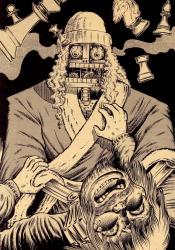Ambrose Bierce, “Moxon’s Monster” (1899)
Summary
The short story begins with a discussion between Moxon, a self-described "inventor and contructor of machines", and the narrator about the nature of consciousness and whether automatons can think. Moxon uses examples from nature, such as plant tropism and the precise organization of crystals, and Herbert Specer's definition of life to argue that all matter has consciousness because "consciousness is the creature of Rythmn". Exasperated with the conversation, the narrator leaves Moxon's rooms but goes back when he has an epiphany and realizes the truth in Moxon's reasoning. He returns to see Moxon playing chess with an automaton who, upon Moxon's victory, strangles his inventor. The narrator then wakes up in the hospital and learns of Moxon's death from Haley, Moxon's hired metalworker.
Motion and Consciousness
There is a strong corellation drawn in the story between motion and consciousness, as consciousness arises from rythmn and action. In Moxon's examples, it is the motion of the plants and the motion of the atoms of a crystal that make them conscious. Similarly, the movements of the robot are what make the narrator uneasy and the robot is consumed by motion, in the form of convulsions, just before it kills Moxon. Moxon expouses a very external view of consciousness; he believes that if the actions or movements of an entity make it appear to be making decisions, it must be regarded as conscious.

